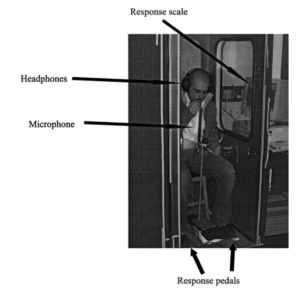We’ve all heard of optical illusions. Did you know that there are taste illusions too?
It all started with a potato chip. One by one, study participants were ushered into a soundproof booth, where they were instructed to bite into a Pringle with their front teeth, then rate how crisp or fresh the chip was. But this was no normal snack session – with every Pringle, the research team would manipulate the sound of the bite, making it louder or softer. The results? When the participants heard a loud, satisfying crunch, they rated the Pringle as delightfully crispy and fresh. When they heard a soft crunch they rated the chip as stale. Even though each Pringle came from the same tube, most of the participants thought the chips were from different packages!

The resulting paper, “The Role of Auditory Cues in Modulating the Perceived Crispness and Staleness of Potato Chips,” won the authors Massimiliano Zampini and Charles Spence the 2008 Ig Nobel Nutrition Prize. The Ig Nobel Prizes honor “improbable research… that makes people laugh, then think,” and in this case the potato chip study helped spark the field of gastrophysics.
Dr. Charles Spence, one of the study’s authors, is the pioneer in the field of gastrophysics and the current leader of the Crossmodal Research Laboratory at the University of Oxford. He defines gastrophysics as “the combination of gastronomy and psychophysics – gastronomy being the knowledge and understanding of all that relates to man as he eats, and psychophysics being the branch of psychology that deals with the relations between physical stimuli and mental phenomena.” In other words, gastrophysics studies the multisensory experience of eating, and how all of our senses contribute to the way we perceive our food and drink.
Think about the pleasure of drinking coffee (or tea, or hot chocolate) with your hands wrapped around a warm mug, the comforting scent drifting upward. Now think about drinking that same hot beverage out of an insulated travel mug. You can’t smell your drink, the mug isn’t warm, and you’re in a rush. It’s the same drink, but the experience simply isn’t as pleasurable because the sensory context has changed.
Gastrophysics research has found that context is incredibly important when it comes to both perception of food and choices surrounding food. Here are just a few of the most interesting findings.

Color
- Manipulating the color of wine using food coloring can change how it tastes. Wine drinkers will describe white wine that has been dyed red or rosé colored as having flavor notes similar to red wines or red fruit. This even works on wine experts who work in the field!
- The color of plates also matters. Desserts such as strawberry mousse and cheesecake taste sweeter on white plates than black ones, even though participants rate them as the same quality.
Packaging and plating
- People like food more when served in a dish that weighs more, and they also expect that the food will be more filling. Furthermore, they will pay more for wine, soda, and chocolate in a heavier bottle or package.
- Heavier cutlery has also been shown to make a meal more enjoyable. People will also pay more for a meal served on heavy cutlery, likely because of the cultural expectations. You wouldn’t expect a five-star restaurant to give you a plastic fork, for example!
Music and noise
- Background music can change what people buy. If a store plays French music they sell more French wines, and if they play German music they sell more German wines. And if classical music is playing (versus top 40), people will spend more– a phenomenon that has been demonstrated in wine shops, university cafeterias, and an African-themed restaurant.
- Loud noises can blunt our sense of taste, which could be why airplane food tastes so bad! However, the taste of umami or savory is not as blunted as the other basic tastes by loud background noise. This could explain why so many people order tomato juice or a Bloody Mary on airplanes– these drinks are rich in umami.
- Chef Heston Blumenthal, long-time collaborator of Dr. Spence and co-author of The Perfect Meal: The Multisensory Science of Food and Dining, found that people rate oysters as much more delicious when listening to a seascape than sounds of barnyard animals. This inspired Blumenthal to create the sashimi dish “The Sound of the Sea,” which is served with a soundtrack of crashing waves and seabirds.
This brings us back to the potato chip study and our sense of hearing. Dr. Spence has said that “sound is the forgotten flavour sense,” and several of his projects revolve around the idea of sonic seasoning: changing the way a dish is perceived by changing the background sound.

Photo by Sandeep Kr Yadav on Unsplash
So, how can you hack your taste buds and experience sonic seasoning at home? It’s surprisingly simple! All you need is some dark chocolate or other bittersweet food like coffee or a dark beer, and some music. Queue up a high-pitched song like Vivaldi’s “Spring,” and a low-pitched song like Liszt’s “Nuages Gris,” or use the custom soundtracks Taste 1 and Taste 5 found in this article about sonic seasoning by the podcast Gastropod. Let one of the dark chocolate melt on your tongue while listening to one of the tracks, then switch to the other. Pay close attention to how the chocolate tastes!
Gastrophysics researchers have consistently found that low pitches are associated with bitterness and high pitches are associated with sweetness. So if you’re like me (it doesn’t work on everyone), changing the songs can change which flavor jumps out – chocolate will suddenly become much more bitter when listening to low pitched sounds. This “taste illusion” is a profound example of how easily our brains can be fooled by cross-talk between the senses.
Eating is one of the most mundane and exciting activities we humans participate in. Gastrophysics research shows that there is more to taste than meets the tongue.
Want to learn more? Check out these resources:
- “Gastrophysics: The New Science of Eating” by Charles Spence (book; Find at UNC)
- “The Perfect Meal: The Multisensory Science of Food and Dining” by Charles Spence and Betina Piqueras-Fiszman (book)
- Sonic Seasoning by Gastropod (podcast)
- Why Lefties Buy Less Soup by the Sporkful (podcast)
- Sonic Seasoning by Twenty Thousand Hertz (podcast)
Peer edited by Odessa Goudy